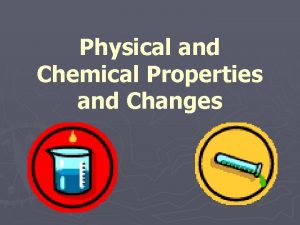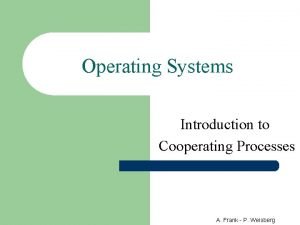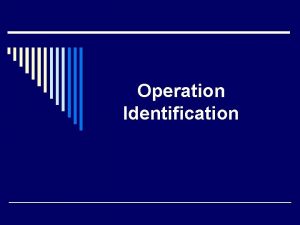A Neurosurgical Operation A neurosurgical operation has several

























- Slides: 25

A Neurosurgical Operation

A neurosurgical operation has several stages • Induction of Anesthesia • Line Insertion – Local anesthesia • Induction – General anesthesia • Maintenance of anesthesia • Initiation of Neuromonitoring • The Operation • Termination of Anesthesia

Line Insertion – Local Anesthesia Insertion of an arterial line for blood pressure monitoring Lidocaine HCL

Local Anesthesia • Erythroxylon coca, a shrub growing high in the Andes mountains – appreciated for centuries by the Peruvian people. • The plant ash releases an alkaloid in a form that can be absorbed across mucous membranes. • The pure alkaloid of cocaine was isolated in 1880. • In 1884, cocaine was used clinically as a local anesthetic in ophthalmology, dentistry, and surgery. • In 1905, the first synthetic local anesthetic, procaine, was developed.

Local Anesthesia • There are currently 16 chemical agents used in local anesthesia; lidocaine, bupivacaine, and tetracaine are the most commonly used in clinical practice. • Local anesthetics are used to decrease pain, temperature, touch proprioception, and skeletal muscle tone. • Used in a variety of clinical situations, from topical application to the skin or mucosa membranes to injectable agents used for peripheral, central, or spinal nerve block. • All work in approximately the same way

Lidocaine – a local anesthetic All local anesthetics reversibly block nerve conduction by decreasing nerve membrane permeability to sodium. This decreases the rate of membrane depolarization, thereby increasing the threshold for electrical excitability.

Lidocaine – a local anesthetic All nerve fibers are affected, albeit in a predictable sequence: autonomic, sensory, motor. These effects diminish in reverse order.

Why we have to learn about axons, ion channels & how they work 1. Local anesthetics: an everyday example used in a variety of medical disciplines 2. Axons are the prototypical “nerve fiber”. Knowing how they work facilitates an understanding of much of neuroscience. 3. Axons are involved in a range of very common medical diseases that you will all see. 4. It will be on the exam.

We’ll get back to the operation Once we can get the arterial line into the patient without them jumping off the table.

Anatomy of the axon

Anatomy of the axon

Axons behave very differently from dendrites In Health (their physiological role) And in Disease (their pathological response)


Axon Anatomy Axons are cables composed of a tube surrounded by a cell membrane +/insulation (myelin). From: Li S, Mealing GA, Morley P, Stys PK J Neurosci 1999 Jul 15; 19(14): RC 16

Axon Anatomy The tubes of large axons are wrapped with myelin

Axon Anatomy Myelin is produced by oligodendrocytes

Axon Anatomy Myelination:

Axon Anatomy The tube contains A cytoskeleton used for - Transporting stuff (axoplasmic transport) - Maintaining structure - Trafficking and anchoring cytoplasmic and cell membrane components. Organelles, and the stuff being transported (proteins, neurotransmitters, etc…)

Axoplasmic transport -Axonal transport controls the distribution of membranes and secretory proteins in the neuron -Transport is anterograde and retrograde -Both anterograde and retrograde transport have fast and slow components.

Fast transport Fast anterograde transport depends on microtubules & MTassociated ATPases (kinesins) that move large components (e. g. , organelles) at high rates > 100 mm / day

Other transport: • Slow anterograde transport serves to move smaller elements such as cytoskeletal and other proteins at 0. 2 -5 mm/day • Fast retrograde transport moves at ½ to 2/3 the rate of fast anterograde transport. Serves to recycle large elements back to the cell soma, and also to inform the body about what’s happening at the other end (e. g. , retrograde transport of hormones, and other signaling molecules)

Axon Anatomy- The Node

Axon Anatomy ->Physiology

More About the tube: The tube & its membrane contain - The Cytoskeleton - Organelles - Ion Channels - Ion Exchangers/Transporters - Neurotransmitter Exchangers/Transporters - Enzymes

To Understand How the Axon Works, we need to understand: 1. Ion Channels 2. Concepts of Diffusion 3. Basic Concepts of Electicity 4. How to Put 1 -3 Together
 St. valentine's day has roots in several different legends
St. valentine's day has roots in several different legends A food handler pulled a hotel pan
A food handler pulled a hotel pan Chemical.properties examples
Chemical.properties examples The cpld contains several pld blocks and
The cpld contains several pld blocks and A consumer confidence researcher asks several retailers
A consumer confidence researcher asks several retailers Montresor acts as judge jury and executioner of fortunato
Montresor acts as judge jury and executioner of fortunato Basic paragraph structure
Basic paragraph structure Several means
Several means Connecting lans
Connecting lans Authors name
Authors name A situation where several processes access
A situation where several processes access My hometown is famous for several amazing natural features
My hometown is famous for several amazing natural features It encompasses several different aspects, including
It encompasses several different aspects, including Several different classes make up
Several different classes make up Charcoal in a fire turns to ash after several hours.
Charcoal in a fire turns to ash after several hours. Who does atticus suggest beat mayella
Who does atticus suggest beat mayella 8 major levels of classification
8 major levels of classification Balancing of several masses rotating in the same plane
Balancing of several masses rotating in the same plane An analogous color scheme combines several hues that:
An analogous color scheme combines several hues that: Secretly kayla was thrilled to return to school
Secretly kayla was thrilled to return to school Several different classes make up
Several different classes make up Harding made several distinguished appointments to his
Harding made several distinguished appointments to his Many several
Many several Flowchart purchasing department
Flowchart purchasing department Mixture of many gases
Mixture of many gases Kingdom family genus species
Kingdom family genus species
















































